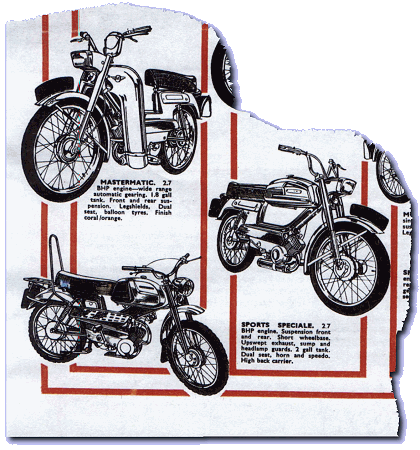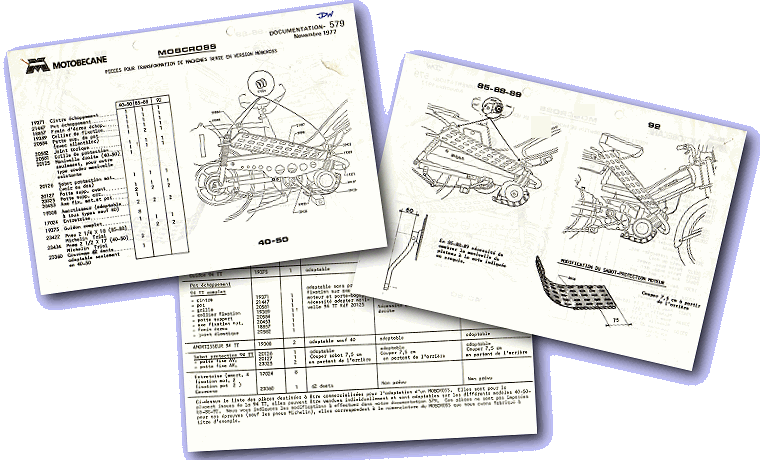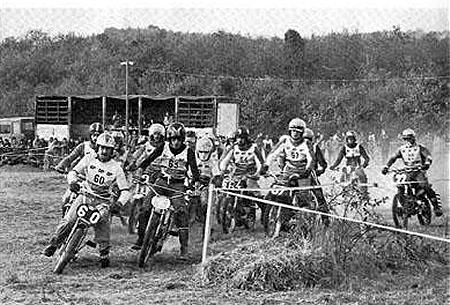This particular Mobylette main feature begins when the AV7 engine is first run backwards on the roller-drive BG model, introduced in 1956 in a steel tubular frame.
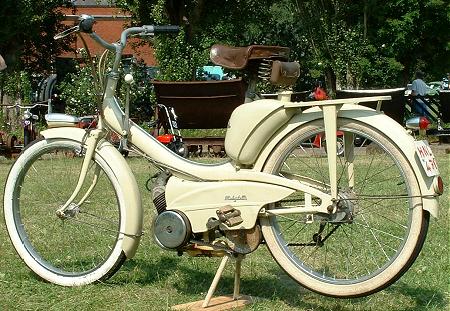 Looking at the engine from the
right-hand (magneto) side, the Motobécane motor
conventionally rotates in a clockwise direction, but because of
the indirectly driven roller on the BG model, the same motor was
required to turn anti-clockwise.
Looking at the engine from the
right-hand (magneto) side, the Motobécane motor
conventionally rotates in a clockwise direction, but because of
the indirectly driven roller on the BG model, the same motor was
required to turn anti-clockwise.
Using the same magneto back-plate, this change only required a ‘mirror-image’ set of contacts, a reverse direction contact cam, and the motor simply timing in the opposite direction.
 Initially direct-drive,
the BG model also became available with a Di-Moby single-speed
automatic clutch, until 1962 when the tubular frame was joined by
a new BG43 pressed-steel frame model, which subsequently replaced
the old model in 1963.
Initially direct-drive,
the BG model also became available with a Di-Moby single-speed
automatic clutch, until 1962 when the tubular frame was joined by
a new BG43 pressed-steel frame model, which subsequently replaced
the old model in 1963.
Along with the BG43 in 1962, came something completely new, also with reverse running motors, the AV98 Sommet and SP98 ‘Sports’ with a motor cycle style fuel tank atop the frame. The engines in both models were fan-cooled with variator automatic gearing, however on these machines the engines were fixed in position and didn’t ‘swing’ like the usual variator models. Motobécane had now introduced a reactive relay-box, so a sprung rear cone set expanded in reaction to the forward centrifugal variator closing. This operation maintained constant belt tension between the front & rear cone sets, and effectively increased the variated ratio range.
No longer would the engine need to swing to enable the single variator’s limited ratio range, Motobécane’s new compact CVT (Continuously Variable Transmission) system would double the gearing spectrum-however there were side effects…
There would be no need for a pedal chain set as the relay-box enabled this capability through the main drive chain, but the relay-box also now transferred the drive line out to the right-hand side of the bike instead of the left. Also the whole relay-box mechanism of pinion and reduction gearing lubricated in heavy 140-grade gear oil introduced a power sapping factor of drag that wasn’t so conducive to an application with a small capacity engine.
The AV98 Sommet was based upon a derivation of the AV89 frame, and the SP98 upon the SP50 Sports Spéciale. The ‘sports’ was also available as a D98SP unrestricted version that needed to be registered as a vélomoteur.
The BG43 roller-drive model was discontinued in 1966, and none of the roller-drive models was ever imported for sale into the UK market.
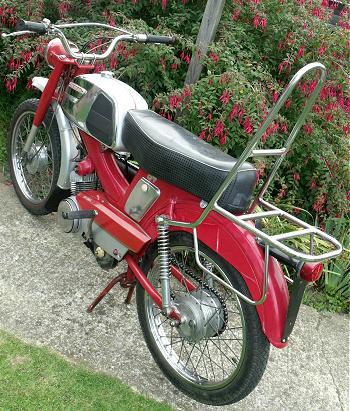 Another new and quite
fantastic relay-box variant was introduced in June 1968 …
Motobécane had been making Sports versions of its mopeds
right back as far as its first Spéciale 50 presented at
the Paris Salon in October 1960 … but nothing quite like
the SP94TT, which was first imported to the UK from November
1972.
Another new and quite
fantastic relay-box variant was introduced in June 1968 …
Motobécane had been making Sports versions of its mopeds
right back as far as its first Spéciale 50 presented at
the Paris Salon in October 1960 … but nothing quite like
the SP94TT, which was first imported to the UK from November
1972.
All other Motobécane Spéciale models had been ‘road sports’ styled, but our 1973-registered SP94TT is ‘off-road styled’—it’s a trail bike!
The SP94TT utilised the SP50 Sport Spéciale type frame with sports top-tank, but was fashioned for dual-use, though an off-road style moped might seem a little far-fetched due to a general lack of power from 50cc engines of the time. Using the new ‘square-barrel’ AV89 motor with 9:1 compression head, the engine was mounted at a more inclined angle to fit the frame with the relay box, and there was only space to squeeze in a new Gurtner AR13 carburettor instead of the AV89’s Gurtner H14, a change which dropped 0.2bhp, so given power of the SP94TT was down rated to 2.5bhp.
All the expected features are included, top tank and dual seat, but this machine came with special Hutchinson 2.50×17 knobbly pattern trail tyres, high front mudguard, high-level exhaust, wide handlebars with a brace, and big stone guard headlamp-but there are some unlikely aspects too … it’s still a moped, and who could imagine an off-road bike with pedals?
Then there’s that rear carrier … with a chopper backrest? While you’re trying to puzzle what that’s about, yes, it is a completely original fitting, but maybe you have to put your mind back to the early 1970s and the ‘Easy Rider’ chopper generation? As a positive point to the upstanding pillion backrest, it gives a handy place to park your helmet when you get off the bike, but otherwise is seemingly just decorative and purposeless, since our bike is not fitted with rear footrests and presumably not intended to carry a passenger?
A lever fuel tap is centrally mounted at the back of the tank off–down for on–reserve, with a stiff operation for the plastic lever that felt as if it might snap off at any time.
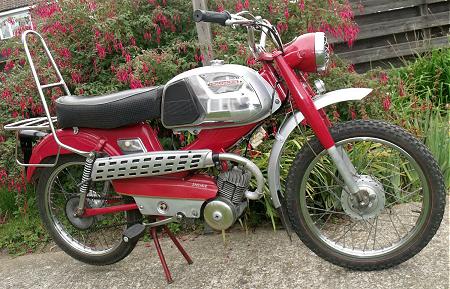 Because the TT was the
flagship model, you’d be paying a lot more money if you
were buying a Sport Spéciale 94 (£172.99p), and all
the controls are better quality, with long and slender Courbevoie
brake levers and a Saker cursor throttle. Instead of the
more usual ‘turn forward to decompress’ twistgrip,
SP94’s decompresser operates by pulling in a small trigger
beneath the front brake lever, and the choke works by pushing a
thumb-lever beneath the left-hand rear brake lever. All
quite different operations from the usual models, otherwise the
principle is much the same, push down on a pedal and, as the
motor spins, release the decompresser trigger. If
you’re lucky it might start on the stand, but it’s
not an easy technique to get the motor to catch. If not,
try again, or just pedal it away for a flying start.
Because the TT was the
flagship model, you’d be paying a lot more money if you
were buying a Sport Spéciale 94 (£172.99p), and all
the controls are better quality, with long and slender Courbevoie
brake levers and a Saker cursor throttle. Instead of the
more usual ‘turn forward to decompress’ twistgrip,
SP94’s decompresser operates by pulling in a small trigger
beneath the front brake lever, and the choke works by pushing a
thumb-lever beneath the left-hand rear brake lever. All
quite different operations from the usual models, otherwise the
principle is much the same, push down on a pedal and, as the
motor spins, release the decompresser trigger. If
you’re lucky it might start on the stand, but it’s
not an easy technique to get the motor to catch. If not,
try again, or just pedal it away for a flying start.
Despite the big 115mm Luxor headlamp, illumination is not at all helped by the ornamental fashion stone guard, which slices-and-dices the beam in every direction … but it looks good … doesn’t it? The Wipac S446 rear lamp was standard fitment for the UK market so as to illuminate the rear number plate. Completing a total mix of SP94’s standard electrical fittings, a Lyon 4-way switch works off-dip-head, though offers little discernable difference from the lighting positions, and a horn button.
The 100mm Atom full-width alloy hub brakes worked well, especially helped by the long Saker levers, which really enabled the rider to generate a strong braking action if required. You quickly got used to the retarding power this brake arrangement could give, allowing the rider to leave braking that little bit longer before diving into corners. Handling was firm and the bike was well planted on the road, giving a confident ride.
After the initial acceleration phase where the CVT transmission moved up its ratio range, the bike gave quite a dull ride as it laboured along in a totally over-geared state, with nothing but a flat drone to add to the rider’s disappointment.
While the 60mph Huret speedometer displayed readings around 15% optimistic to try and encourage our impression, the pace vehicle wasn’t to be fooled. Best on flat in a crouch indicated around 40ish, but our pacer only clocked this at 34. Our downhill run saw the dial beyond 50, but alas our pacer only saw 44, and the following uphill climb was accomplished capably enough with our speed falling to 24 before cresting the rise (indicated 30ish).
The indicated ‘ish’ readings are because we could only gauge a general indication while the needle was swinging across the face of the dial more like a windscreen wiper than a speedometer. Not our Huret’s finest hour!
 Further relay-box models AV92
& SP93 in October 1969 introduced a new ‘long
frame’ style to better accommodate the transmission unit,
with the Sport Spéciale SP93 coming to the UK first in January 1970, and shortly
followed by the AV92 in December 1971.
Further relay-box models AV92
& SP93 in October 1969 introduced a new ‘long
frame’ style to better accommodate the transmission unit,
with the Sport Spéciale SP93 coming to the UK first in January 1970, and shortly
followed by the AV92 in December 1971.
Our 1974 registered ‘Mastermatic’ AV92 (priced at £159.99p) features a step-through, tank-in-frame chassis. The orange paint was a common finish, but other colours were available. The chrome tank side panels continue a familiar style from earlier models, but these are a new pressing form finished with clip-in plastic trims.
Though mounting the same side panels as the SP94TT, the ‘long frame’ no longer employs the traditional practice of mounting the toolbox cavity through the frame beneath the seat, and closing each side with aluminium pressed covers-the AV92 has long plastic moulded left-hand & right-hand toolbox cover housings attached to the frame beneath the seat.
Wheels and tyres are 2.50×18 size; unlike the SP94TT they are shod with road pattern tread tyres. The power-plant is the same square-barrel AV89 engine, with Gurtner AR13 carburettor and rated at 2.5bhp.
Starting is traditional Mobylette with all the usual and familiar controls, a push on–pull off plunger petrol tap knob emerges through a hole in the top of the right-hand side panel, trigger choke under the left-hand bar grip, forward decompress with the twistgrip, then throttle back as the engine spins.
The long silencer barrel reduces exhaust tone to little more than a smooth hum, while acceleration is positive and progressive in the initial phase, but all performance seems to flatten out once the CVT variates into its upper range where the bike just feels sluggish and unresponsive.
Best on flat in upright position indicated 30, actual 27-28mph clocked by pace vehicle.
Best on flat in crouch indicated 32-33, actual 31mph clocked by pace vehicle.
Downhill run indicated 36, actual 41mph.
Uphill climb indicated down to 23 before cresting the rise, actual 24mph clocked by pace vehicle.
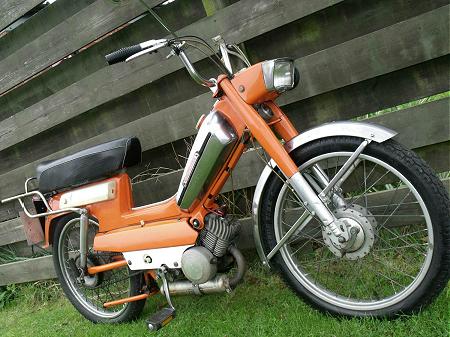
Indications from the 60mph Huret speedometer appeared quite variable throughout its range, seemingly showing a little low up to 25, then fractionally fast between 25 & 33, until finally registering much more difference in speed above 33mph … our conclusion being that possibly lubricant in the speedometer mechanism might have dried out and become sticky?
The brakes were very effective, and well beyond the performance of the bike.
Handling was also very good, so it was possible to ride this moped quite hard with the confidence you could leave braking till late on entry to a bend, and corner at a good pace. The disappointment was that once you came out of a corner and opened up … it had nothing to give in further performance.
You could ride one of these bikes flat-out all day and never be thrashing it, since the motor is so over-geared, it simply won’t rev.
The large rectangular headlight unit is sized 120mm wide × 70mm deep, with a proper glass lens, which makes a little more use of the 18/18W lamp.
The 24½-inch dual saddle provided a very comfortable seat for a solo rider to luxuriate in its ample space, and still with plenty of room to accommodate a pillion passenger if required. The bike is fitted with rear footrests mounted off the back axle, so is certainly intended to carry two people and, with its low range CVT gearing, would seem quite capable of pulling away satisfactorily enough two-up. It’s just that when the variator graduates to high range, then it’s going to go even slower…
With the rear carrier sticking out the back of the bike, our AV92 measures 78 inches tip-to-tail (very nearly 2 metres), and this is going to fill up a little more space in your garage than the average moped.
 Our featured SP93 (listed at
£168.99p) was titled as a Sports ‘50’ Mark II
for the UK market, and is a
late registered example dating from 1975, finished in the typical
original colours of black frame with red tank and silver/red
flash trim panels.
Our featured SP93 (listed at
£168.99p) was titled as a Sports ‘50’ Mark II
for the UK market, and is a
late registered example dating from 1975, finished in the typical
original colours of black frame with red tank and silver/red
flash trim panels.
Unlike the AV92 with 18-inch wheels, the SP93 has 2.50×17 wheels & tyres. It’s a bit of a puzzle why Motobécane chose to equip this particular model this way compared to the other road-going model. Under general circumstances one may be inclined to think this could represent a slightly lower top speed ability, but because the other relay-box models seem so dramatically over-geared in high ratio, then this could work slightly in the 93’s favour, and it may even go a little better as a result-however we don’t think it’ll be enough of a reduction to make any significant difference. We figure the drive ratio would need to be more dramatically reduced to make a better bike out of a relay-box model … still, we’ll see …
The SP93 uses the same ‘long frame’ as the AV92, though in this case the main pressings are formed without the integral tank-in-frame, so a new ‘humpback’ sports style top-tank is fitted to bridge the gap between the headstock and the saddle. This leaves a big empty gap in the middle, but you don’t notice this when you’re riding the bike, and it feels just fine. The tank is trimmed with the traditional chrome trims and rubbery knee grips to continue a comfortable motor cycle feel. The off–on–reserve fuel cock locates under the left hand side of the tank, and looks to be the same device as the SP94TT wore, except this tap lever seems to switch position more easily, so perhaps the 94 tap required some servicing? All other controls are the same as the AV92, so all very familiar.
The lightly tweaked engine on this bike runs a higher compression ratio, giving a good punchy acceleration effective right through the mid range, but once the variator shifts into high ratio the bike seems to have nothing more to give as, despite the smaller diameter wheels, it still appears to be quite over-geared.
 The Huret 60mph speedometer on this bike maintained a
slightly optimistic outlook throughout its range.
The Huret 60mph speedometer on this bike maintained a
slightly optimistic outlook throughout its range.
Cruising upright along the flat at an indicated 30, the pace recorded at 28-29.
Best on flat in crouch indicated 33, pace vehicle showed 31-32.
Downhill run indicated around 42-43, which the pacer clocked at 39mph.
Uphill climb dropped back to an indicated 25, which our pacer reported as 22.
Overall the SP93 rode well, handled well, was firmly planted on the road, climbed hills well, stopped well, showed good lights, but demonstrated disappointing upper range performance in exactly the same manner as its stable mates.
The CVT transmission delivers useful torque in the low/mid range, but seems hopelessly over-geared in its higher ratio. Though effectively dealing with everything within their range, Motobécane’s relay-box models are generally a dull and monotonous ride. So where did Motobécane’s relay-box models go wrong?
The AV89 variator set ranged the overall gear ratio from 11.1 -19.9, giving a 79% range increase. The relay-box CVT ranged the overall gear ratio from 11.53–26.88 giving a 133% range increase, which is all very good, but it starts from a slightly higher base, and ranges to a ratio way above the top drive ratio of the AV89, while the engine output is lower by 0.2bhp due to the carburettor change, and the relay-box transmission is more power sapping.
Simple mathematical analysis suggests the drive ratio range wasn’t right, and the reality was demonstrated by poor performance of Motobécane’s relay-box system on all its models.
What was suggested by the mathematics was exactly demonstrated by our test machines, and we think the Moby relay-box models should have been geared down some 30% to make better bikes of them.
Only a 39-tooth rear sprocket was ever available, but we think it should have been 50-tooth.
UK Imports of SP93 & SP94TT ceased in June 1975, but the AV92 continued up to March 1976.


